CHEVROLET SUBURBAN 1997 Owners Manual
Manufacturer: CHEVROLET, Model Year: 1997, Model line: SUBURBAN, Model: CHEVROLET SUBURBAN 1997Pages: 433, PDF Size: 21.49 MB
Page 101 of 433
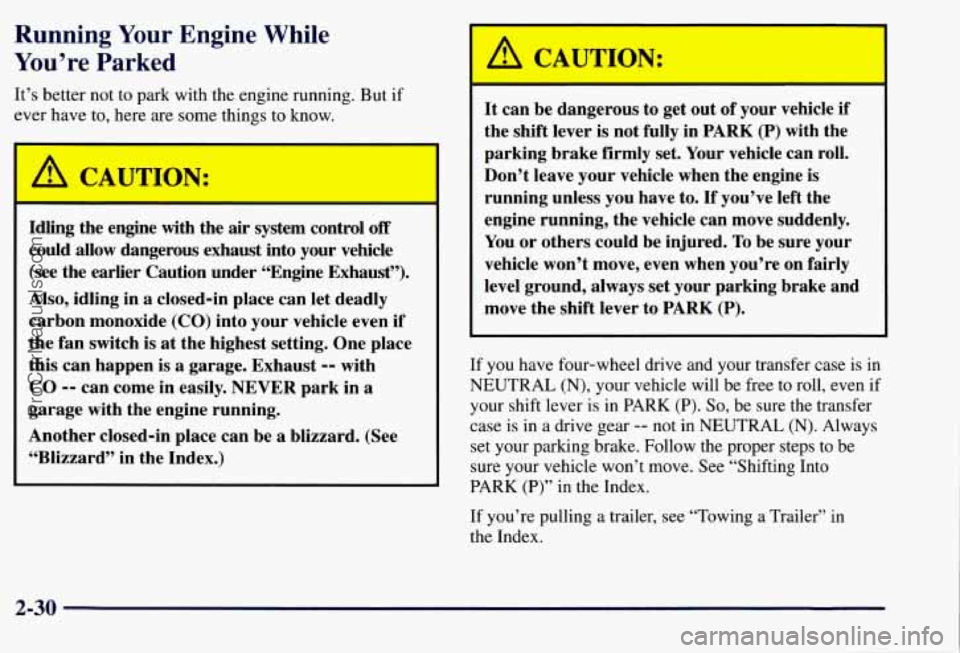
Running Your Engine While
You’re Parked
It’s better not to park with the engine running. But if
ever have to, here are some things to
know.
Idling the engine with the air system control off
could allow dangerous exhaust into your vehicle
(see the earlier Caution under “Engine Exhaust”).
Also, idling in a closed-in place can let deadly
carbon monoxide (CO) into your vehicle even if
the fan switch is
at the highest setting. One place
this can happen is
a garage. Exhaust -- with
CO
-- can come in easily. NEVER park in a
garage with the engine running.
Another closed-in place can be
a blizzard. (See
“Blizzard” in the Index.) It
can be dangerous to get out of your vehicle if
the shift lever is not fully in PARK
(P) with the
parking brake firmly set. Your vehicle can roll.
Don’t leave your vehicle when the engine is
running unless you have to.
If you’ve left the
engine running, the vehicle can move suddenly.
You or others could be injured.
,To be sure your
vehicle won’t move, even when you’re on fairly
level ground, always set your parking brake and
move the shift lever to PARK
(P).
If you have four-wheel drive and your transfer case is in
NEUTRAL
(N), your vehicle will be free to roll, even if
your shift lever is in PARK (P). So, be sure the transfer
case
is in a drive gear -- not in NEUTRAL (N). Always
set your parking brake. Follow the proper steps to be
sure your vehicle won’t move. See “Shifting Into
PARK (P)” in the Index.
If you’re pulling a trailer, see “Towing a Trailer” in
the Index.
2-30
ProCarManuals.com
Page 102 of 433
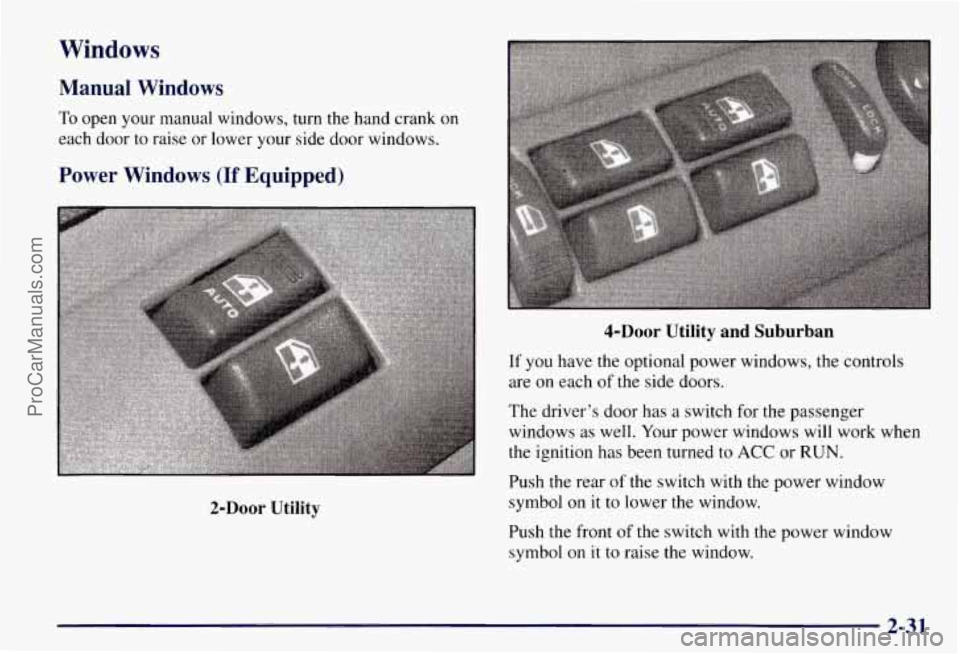
Windows
Manual Windows
To open your manual windows, turn the hand crank on
each door to raise or lower your side door windows.
Power Windows (If Equipped)
2-Door Utility
4-Door Utility and Suburban
If you have the optional power windows, the controls
are on each of the side doors.
The driver’s door has a switch for
the passenger
windows
as well. Your power windows will work when
the ignition has been turned to ACC or RUN.
Push the rear of the switch with the power window
symbol on
it to lower the window.
Push the front of the switch with the power window
symbol
on it to raise the window.
2-31
ProCarManuals.com
Page 103 of 433
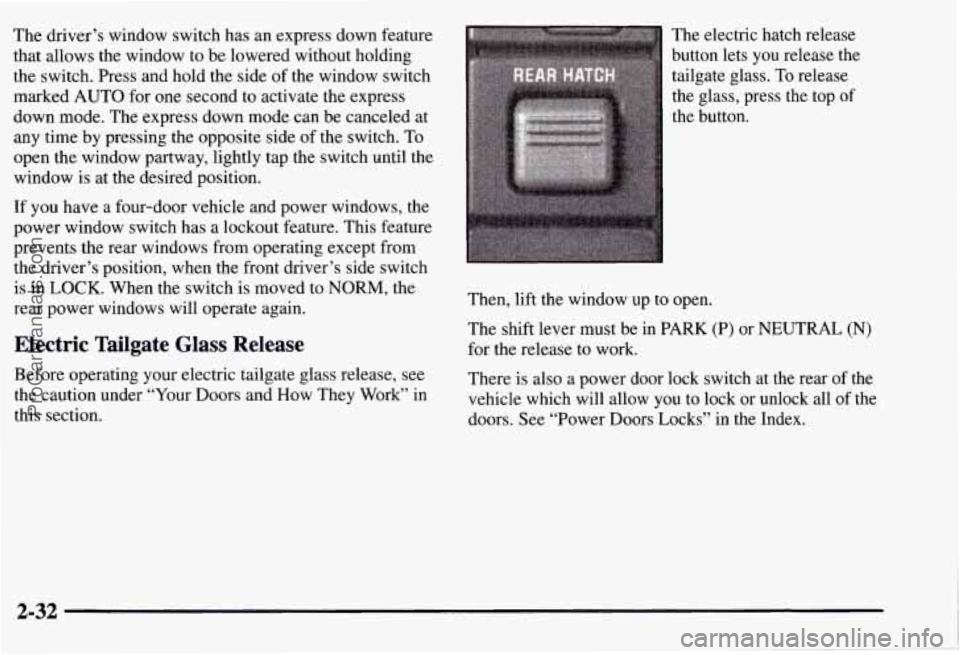
The driver’s window switch has an express down feature
that allows the window to be lowered without holding
the switch. Press and hold the side
of the window switch
marked AUTO for one second to activate the express
down mode. The express down mode can be canceled at
any time
by pressing the opposite side of the switch. To
open the window partway, lightly tap the switch until the
window is at the desired position.
If
you have a four-door vehicle and power windows, the
power window switch has a lockout feature. This feature
prevents the rear windows from operating except from
the driver’s position, when the front driver’s side switch
is in LOCK. When the switch is moved to NORM, the
rear power windows will operate again.
Electric Tailgate Glass Release
Before operating your electric tailgate glass release, see
the caution under “Your Doors and How They Work” in
this section. The electric
hatch release
button lets you release the
tailgate glass. To release
the glass, press the top
of
the button.
Then, lift the window up to open.
The shift lever must be in PARK
(P) or NEUTRAL (N)
for the release to work.
There
is also a power door lock switch at the rear of the
vehicle which will allow you
to lock or unlock all of the
doors. See “Power Doors Locks” in the Index.
2-32
ProCarManuals.com
Page 104 of 433
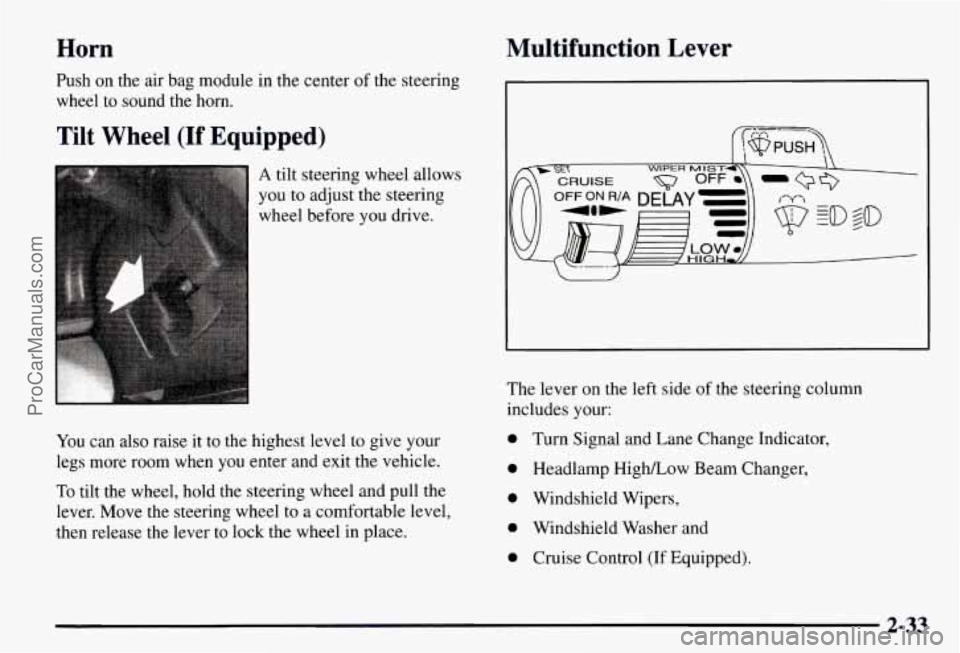
Horn Multifunction Lever
Push
on the air bag module in the center of the steering
wheel to sound the horn.
Tilt Wheel (If Equipped)
A tilt steering wheel allows
you to adjust the steering
wheel before you drive.
You can
also raise it to the highest level to give your
legs more room when you enter and exit the vehicle.
To tilt the wheel, hold the steering wheel and pull the
lever. Move the steering wheel to
a comfortable level,
then release the lever to lock the wheel in place. The lever
on the left side of the steering column
includes your:
0 Turn Signal and Lane Change Indicator,
0 Headlamp HighLow Beam Changer,
0 Windshield Wipers,
0 Windshield Washer and
0 Cruise Control (If Equipped).
2-33
ProCarManuals.com
Page 105 of 433
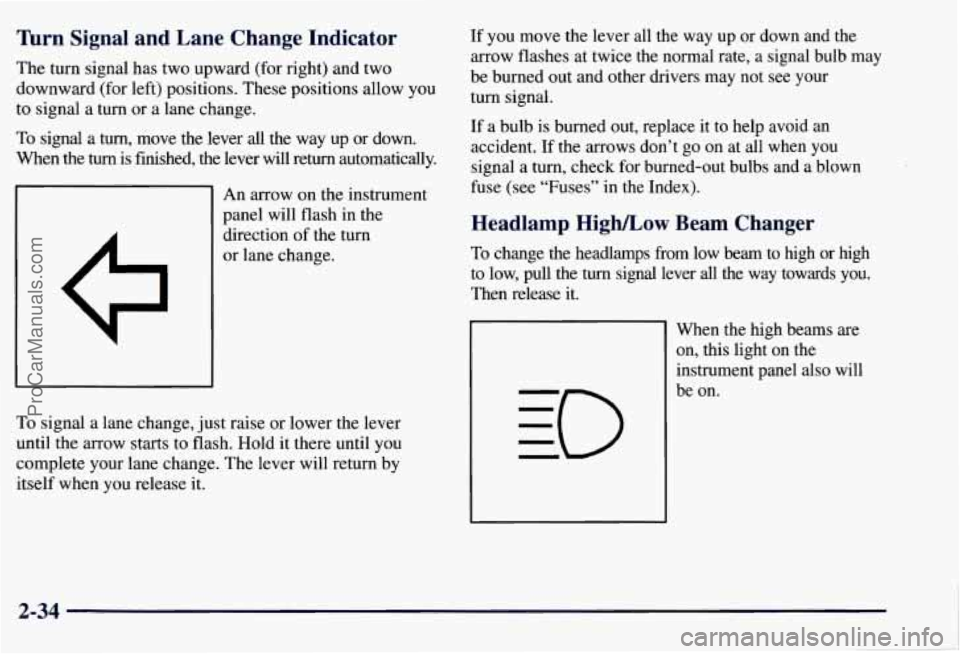
Thrn Signal and Lane Change Indicator
The turn signal has two upward (for right) and two
downward (for left) positions. These positions allow you
to signal a turn or a lane change.
To signal a turn, move the lever all the way up or down.
When the
turn is finished, the lever will return automatically.
Q
An arrow on the instrument
panel will flash in the
direction of the
turn
or lane change.
To signal a lane change, just raise or lower the lever
until the arrow starts to flash. Hold it there until
you
complete your lane change. The lever will return by
itself when you release it. If
you move the lever all the way up or down and the
arrow flashes at twice the normal rate, a signal bulb may
be burned out and other drivers may not see your
turn signal.
If a bulb is burned out, replace it to help avoid an
accident. If the arrows don’t go on at all when you
signal a
turn, check for burned-out bulbs and a blown
fuse (see “Fuses” in the Index).
Headlamp High/Low Beam Changer
To change the headlamps from low beam to high or high
to low, pull the turn signal lever
all the way towards you.
Then release it.
When the high beams are
on, this light on the
instrument panel also will
be on.
2-34
ProCarManuals.com
Page 106 of 433
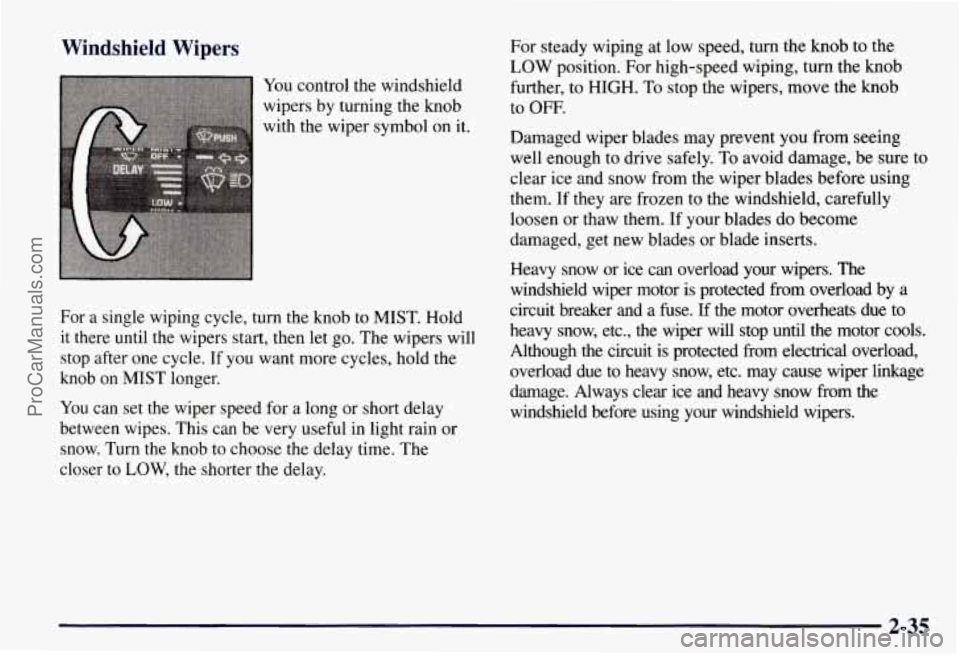
Windshield Wipers
You control the windshield
wipers by turning the knob
with the wiper symbol on it.
For a single wiping cycle, turn the knob to MIST. Hold
it there until the wipers start, then let go. The wipers will
stop after one cycle. If you want more cycles, hold the
knob on MIST longer.
You can set the wiper speed for a long or short delay
between wipes. This can be very useful in light rain or
snow. Turn the knob to choose the delay time. The
closer to
LOW, the shorter the delay.
For steady wiping at low speed, turn the knob to the
LOW position. For high-speed wiping, turn the knob
further, to HIGH.
To stop the wipers, move the knob
to
OFF.
Damaged wiper blades may prevent you from seeing
well enough to drive safely. To avoid damage,
be sure to
clear ice and snow from the wiper blades before using
them. If they
are frozen to the windshield, carefully
loosen or thaw them. If your blades do become
damaged, get new blades or blade inserts.
Heavy snow or ice can overload your wipers. The
windshield wiper motor is protected
from overload by a
circuit breaker and a fuse.
If the motor overheats due to
heavy snow, etc., the wiper will stop until the motor cools.
Although the circuit is protected from
electrical overload,
overload due to heavy snow, etc. may cause wiper linkage
damage. Always clear ice and heavy snow from the
windshield before using your windshield wipers.
2-35
ProCarManuals.com
Page 107 of 433
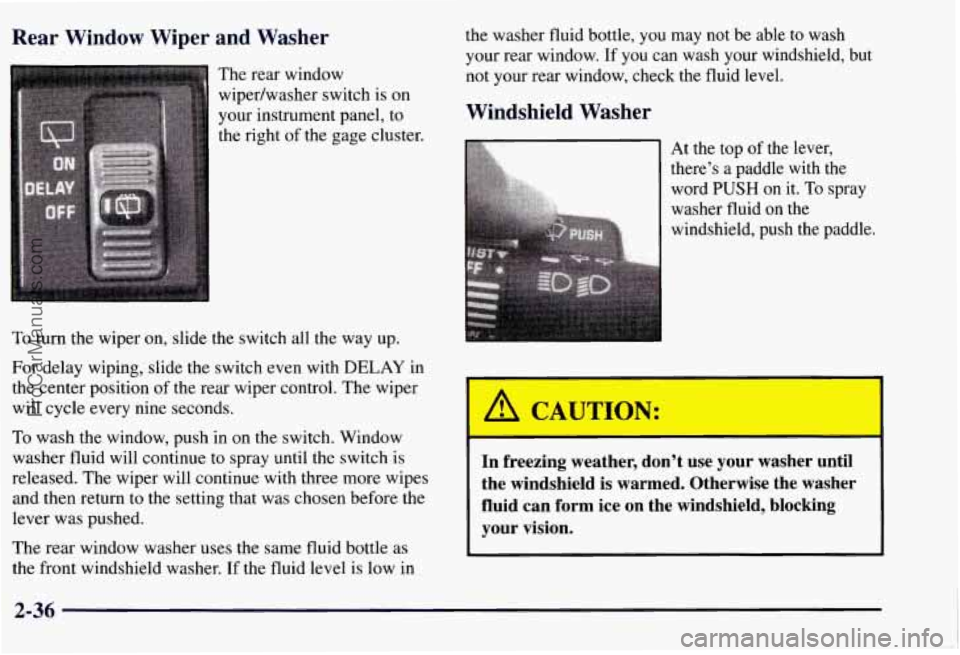
Rear Window Wiper and Washer
The rear window
wipedwasher switch is on
your instrument panel, to
the right of the gage cluster.
To turn the wiper on, slide the switch all the way up.
For delay wiping, slide the switch even with DELAY in
the center position of the rear wiper control. The wiper
will cycle every nine seconds.
To wash the window, push in on the switch. Window
washer fluid will continue
to spray until the switch is
released. The wiper will continue with three more wipes
and then return to the setting that was chosen before the
lever was pushed.
The rear window washer uses the same fluid bottle as
the front windshield washer. If the fluid level is low
in
the washer fluid bottle, you may not be able to wash
your rear window. If you can wash your windshield, but
not your rear window, check the fluid level.
Windshield Washer
At the top of the lever,
word
PUSH on it. To spray
washer fluid on the
windshield, push the paddle.
i there’s a paddle with the &
A CAUTION:
I
-I
In freezing weather, don’t use your washer until
the windshield is warmed. Otherwise the washer
fluid can form ice on the windshield, blocking
your vision.
ProCarManuals.com
Page 108 of 433
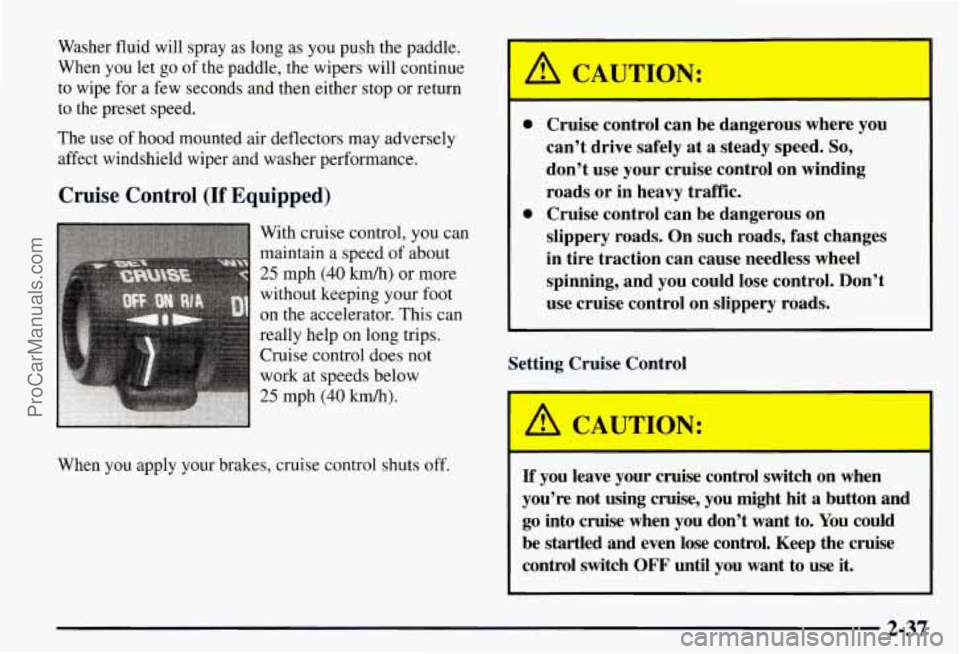
Washer fluid will spray as long as you push the paddle.
When you let
go of the paddle, the wipers will continue
to wipe for a few seconds and then either stop or return
to the preset speed.
The use of hood mounted air deflectors may adversely
affect windshield wiper and washer performance.
Cruise Control (If Equipped)
When you apply your brakes, cruise control shuts off.
0 Cruise control can be dangerous where you
can’t drive safely at a steady speed.
So,
don’t use your cruise control on winding
roads or in heavy traffic.
slippery roads. On such roads, fast changes
in tire traction can cause needless wheel
spinning, and you could lose control. Don’t
use cruise control on slippery roads.
0 Cruise control can be dangerous on
Setting Cruise Control
-
If you leave your cruise control switch on when
you’re not using cruise, you might hit
a button and
go into cruise when you don’t want to. You could
be startled and even lose control. Keep the cruise
control switch
OFF until you want to use it.
I I
2-37
ProCarManuals.com
Page 109 of 433
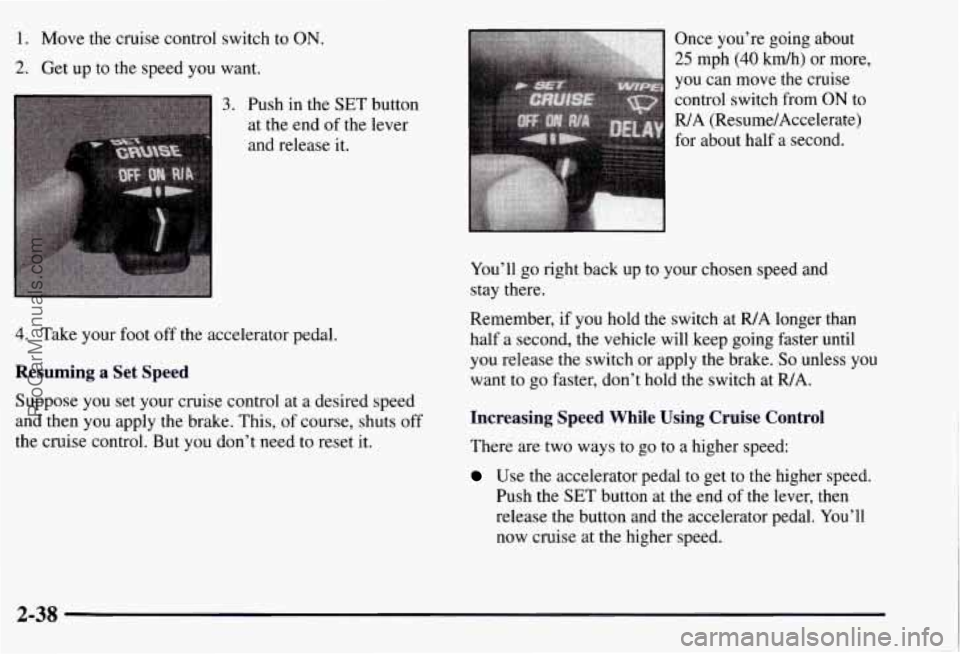
1. Move the cruise control switch to ON.
2. Get up to the speed you want.
3. Push in the SET button
at the end
of the lever
and release
it.
4. Take your foot off the accelerator pedal.
Resuming a Set Speed
Suppose you set your cruise control at a desired speed
and then you apply the brake. This,
of course, shuts off
the cruise control. But you don’t need to reset it. Once you’re going
about
25 mph (40 km/h) or more,
you can move the cruise
control switch from
ON to
R/A (Resume/Accelerate)
for about half a second.
You’ll go right back up to your chosen speed and
stay there.
Remember,
if you hold the switch at R/A longer than
half a second, the vehicle will keep going faster until
you release the switch or apply the brake.
So unless you
want to go faster, don’t hold the switch at
R/A.
Increasing Speed While Using Cruise Control
There are two ways to go to a higher speed:
Use the accelerator pedal to get to the higher speed.
Push the SET button at the end of the lever,
then
release the button and the accelerator pedal. You’ll
now cruise at the higher speed.
2-38
ProCarManuals.com
Page 110 of 433
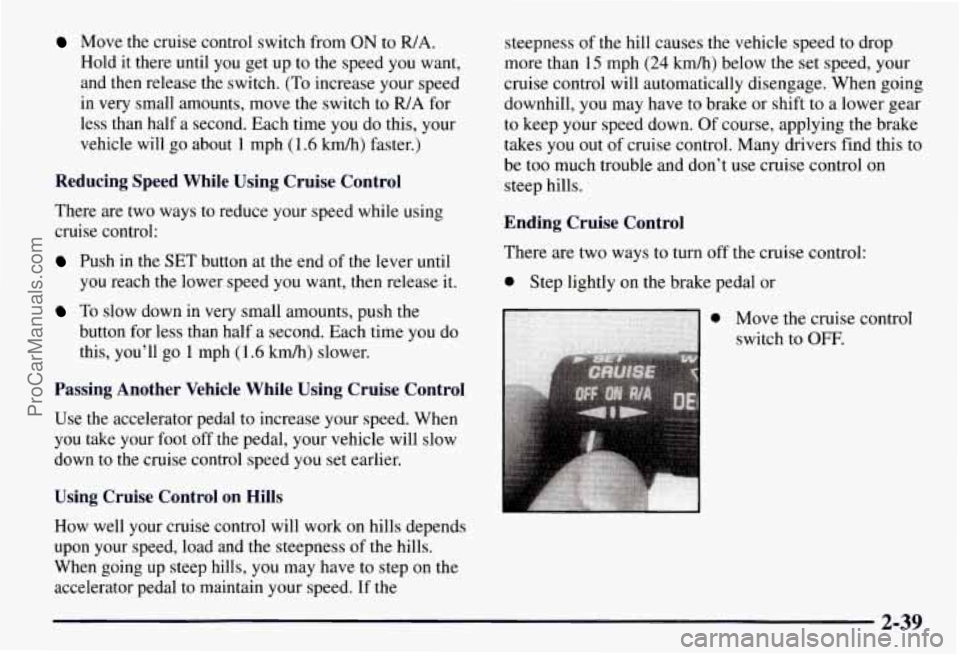
Move the cruise control switch from ON to R/A.
Hold it there until you get up to the speed you want,
and then release the switch. (To increase your speed
in very small amounts, move the switch to
R/A for
less than half a second. Each time you do this, your
vehicle will go about 1 mph (1.6
km/h) faster.)
Reducing Speed While Using Cruise Control
There are two ways to reduce your speed while using
cruise control:
Push in the SET button at the end of the lever until
you reach the lower speed
you want, then release it.
To slow down in very small amounts, push the
button for less than half a second. Each time you do
this, you’ll
go 1 mph (1.6 kmk) slower.
Passing Another Vehicle While Using Cruise Control
Use the accelerator pedal to increase your speed. When
you take your foot off the pedal, your vehicle will slow
down to the cruise control speed you set earlier.
Using Cruise Control on Hills
How well your cruise control will work on hills depends
upon your speed, load and the steepness
of the hills.
When going up steep hills, you may have to step on the
accelerator pedal to maintain your speed.
If the steepness
of the hill causes the vehicle speed
to drop
more than 15 mph
(24 kdh) below the set speed, your
cruise control will automatically disengage. When going
downhill, you may have to brake or shift to a lower gear
to keep your speed down. Of course, applying the brake
takes you out of cruise control. Many drivers find this to
be too much trouble and don’t use cruise control
on
steep hills.
Ending Cruise Control
There are two ways to turn off the cruise control:
0 Step lightly on the brake pedal or
0 Move the cruise control
switch to
OFF.
2-39
ProCarManuals.com